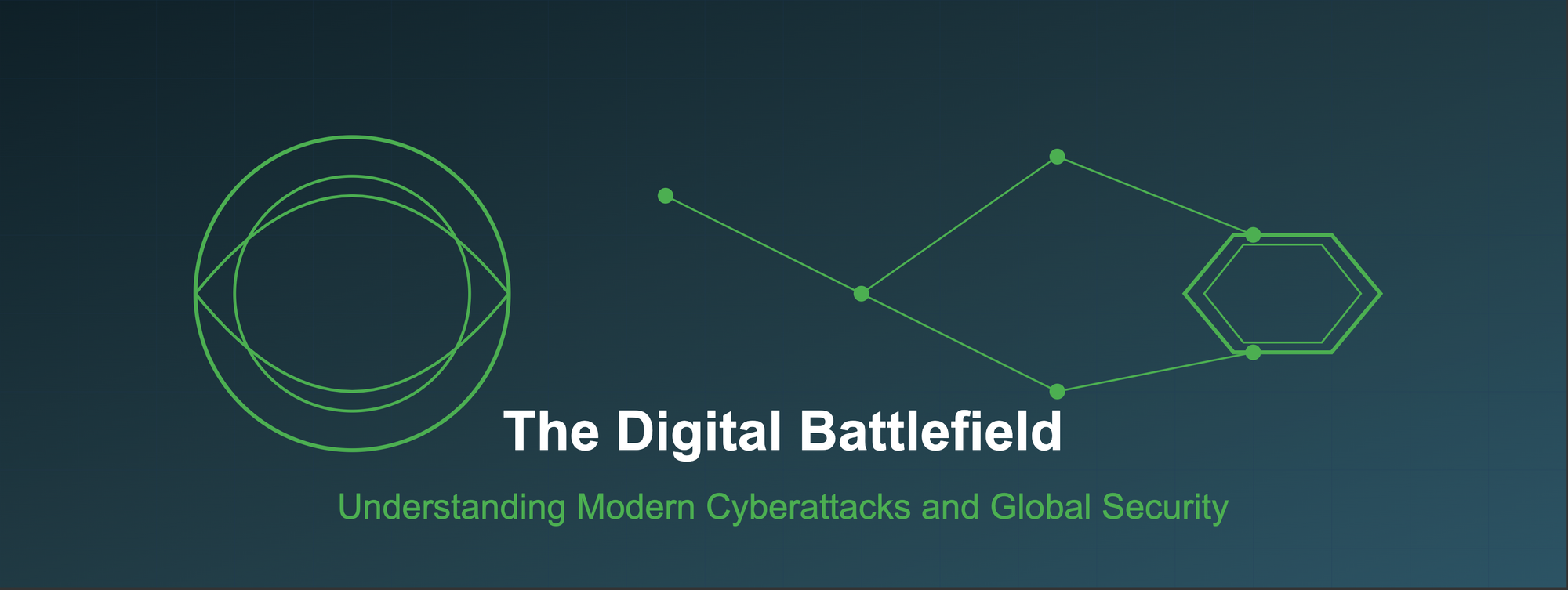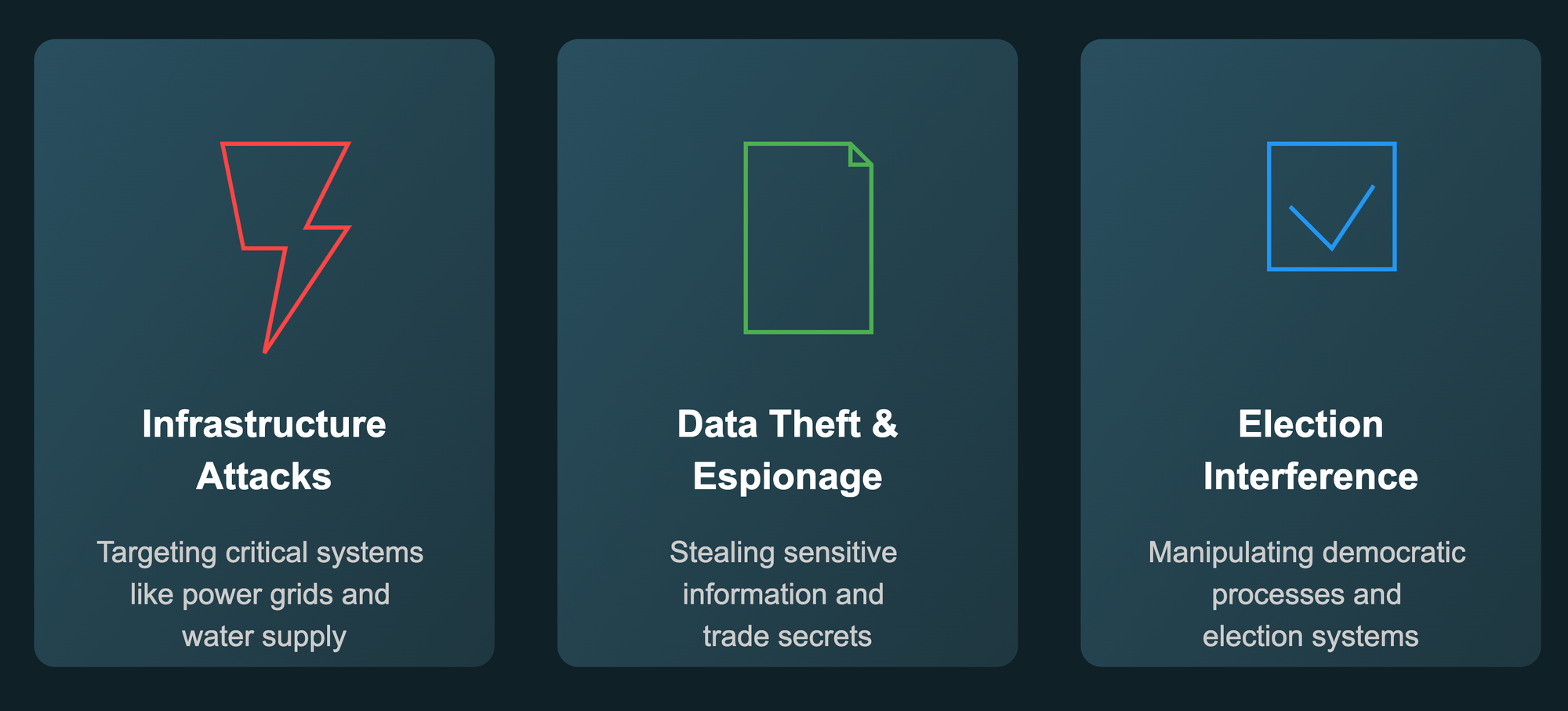
Imagine waking up one morning to find your city's power grid has failed, hospitals can't access patient records, and banking systems are frozen. This isn't science fiction – it's a reality that countries worldwide now face due to modern cyberattacks. Just as we lock our doors to protect our homes, nations must now guard their digital borders against threats that can't be seen with the naked eye.
Understanding Cyberattacks: The Basics
Think of a cyberattack like a digital version of breaking and entering. Instead of physical locks, attackers try to bypass digital security measures. These attacks can range from simple attempts to steal personal information to complex operations that can shut down entire power grids or disrupt government services.
Types of Cyberattacks That Shape Our World

- Infrastructure Attacks
When attackers target a country's essential services – power plants, water treatment facilities, or transportation systems – they can create real-world chaos without firing a single bullet. The 2015 attack on Ukraine's power grid left 230,000 residents without electricity during winter, showing how digital attacks can affect everyday life. - Data Theft and Espionage
Countries and organizations can steal valuable information without ever entering a building. Think of it as digital spying, where attackers quietly copy sensitive documents, research data, or military plans. The 2014 Sony Pictures hack, which exposed private emails and unreleased movies, demonstrates how devastating these attacks can be. - Election Interference
Modern elections face a new threat: digital manipulation. This can include spreading false information on social media, hacking voting systems, or leaking sensitive campaign information. The 2016 U.S. presidential election showed how these attacks can shake public trust in democratic processes.
How Countries Launch Cyberattacks
The Tools of Digital Warfare
Countries use various tools to conduct cyberattacks:
- Malware (Malicious Software)
Think of malware as a digital weapon. The Stuxnet virus, which damaged Iran's nuclear program in 2010, is a famous example. It was so precisely targeted that it only affected specific industrial equipment while leaving other systems untouched. - Social Engineering
Rather than breaking through technical defenses, attackers often trick people into providing access. This is like convincing someone to willingly hand over their house keys rather than picking the lock. - Zero-Day Exploits
These are like finding a secret entrance that nobody else knows about. Attackers discover and use software vulnerabilities before they can be fixed.
The Major Players in Cyber Warfare
United States
The U.S. has some of the world's most advanced cyber capabilities, focusing on both defense and offense. The country has established the U.S. Cyber Command to protect its networks and can conduct sophisticated operations when needed.
Russia
Known for combining traditional hacking with information warfare, Russia has used cyberattacks to support its military and political goals. The NotPetya attack in 2017, which caused over $10 billion in global damages, showed Russia's cyber capabilities.
China
China focuses on long-term strategic goals, often conducting extensive espionage operations to gather intellectual property and military intelligence. Chinese operations typically prioritize collecting information over causing immediate damage.
Protecting Against Cyberattacks
National Defense Strategies
- Critical Infrastructure Protection
Countries must protect their essential services first. This means securing power grids, water systems, and telecommunications networks with multiple layers of security. - Public-Private Partnerships
Since many critical systems are privately owned, governments must work closely with businesses to ensure proper protection. This collaboration helps share information about threats and coordinate responses. - International Cooperation
Cyberattacks don't respect borders, so countries must work together. Sharing information about threats and coordinating responses helps everyone stay safer.
Essential Steps for Protection
- Regular Updates and Maintenance
Just as we service our cars regularly, digital systems need constant updates to stay secure. This includes updating software, replacing old systems, and testing security measures. - Training and Awareness
People are often the weakest link in security. Regular training helps everyone recognize and respond to threats appropriately. - Incident Response Planning
Countries and organizations need clear plans for when attacks occur. This includes backup systems, communication protocols, and recovery procedures.
The Future of Cyber Warfare
The landscape of cyber warfare continues to evolve. Artificial Intelligence is becoming both a new tool for defense and a potential weapon. Quantum computing may soon break current encryption methods, requiring new ways to protect information.
Emerging Threats
- AI-Powered Attacks
Artificial Intelligence can help attackers find vulnerabilities faster and create more convincing fake content for social engineering. - Internet of Things (IoT) Vulnerabilities
As more devices connect to the internet, from traffic lights to medical devices, the potential targets for attacks multiply. - Supply Chain Attacks
Attackers are increasingly targeting the software and hardware supply chain, compromising systems before they're even installed.
Conclusion: Building a Safer Digital World
Protecting against cyberattacks requires constant vigilance and adaptation. Countries must balance offensive capabilities with strong defenses while working together to establish international norms and rules for cyber warfare.
The key to success lies in understanding that cybersecurity is everyone's responsibility – from government agencies to private companies to individual citizens. By working together and staying informed about evolving threats, we can build a more secure digital world for everyone.
As technology continues to advance, our approach to cybersecurity must evolve as well. The future of global security depends on our ability to protect our digital assets while maintaining the open and connected world that has brought so many benefits to society.
https://bit.ly/428BQdl
https://bit.ly/40mCouV
https://guptadeepak.com/content/images/2025/01/The-Global-digital-battlefield.png
https://guptadeepak.weebly.com/deepak-gupta/the-digital-battlefield-understanding-modern-cyberattacks-and-global-security


No comments:
Post a Comment